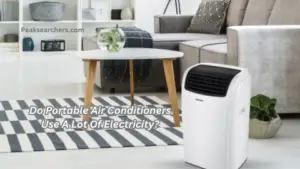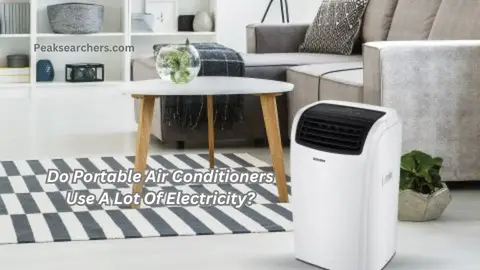Do Portable Air Conditioners Use A Lot Of Electricity? A DIY Guide
Welcome to our comprehensive guide on portable air conditioners and their energy consumption. In this article, we will address a common concern: Do portable air conditioners use a lot of electricity? We understand the importance of energy efficiency and the impact it has on both the environment and your utility bills. Let’s dive deep into the topic and debunk the myth surrounding portable air conditioners and their electricity usage.

Understanding Energy Efficiency Ratings
To accurately assess the energy consumption of portable air conditioners, it is crucial to understand the concept of the Energy Efficiency Ratio (EER) and Seasonal Energy Efficiency Ratio (SEER). EER measures the cooling capacity of an air conditioner divided by the power it consumes, while SEER takes into account the efficiency over an entire cooling season.
The Power Consumption Myth
Portable air conditioners often face criticism for being energy-intensive, but this is not entirely accurate. While it is true that air conditioners, including portable ones, consume electricity, advancements in technology have led to significant improvements in energy efficiency.
Factors Affecting Energy Consumption
To evaluate the energy consumption of a portable air conditioner, it is essential to consider various factors:
1. Cooling Capacity
The cooling capacity of an air conditioner is measured in British Thermal Units (BTUs) and determines its ability to cool a specific area. A higher BTU rating indicates a more powerful unit, which can cool larger spaces more effectively. However, a larger cooling capacity doesn’t necessarily mean higher energy consumption.
2. Room Size
The size of the room plays a vital role in the energy consumption of a portable air conditioner. An oversized unit in a small room will cycle on and off frequently, resulting in energy wastage. Conversely, an undersized unit may struggle to cool the room efficiently, leading to prolonged operation and higher energy usage.
3. Insulation and Air Leakage
Proper insulation and minimizing air leakage in the room help maintain a consistent temperature, reducing the workload on the portable air conditioner. Well-insulated spaces require less energy to cool, leading to improved energy efficiency.
4. Ambient Temperature and Humidity
The ambient temperature and humidity affect the performance of portable air conditioners. Higher temperatures and humidity levels require the unit to work harder, leading to increased energy consumption. However, modern units incorporate smart features and sensors to optimize energy usage based on these factors.
Energy-Saving Tips for Portable Air Conditioners
Now that we have clarified some misconceptions and understood the factors influencing energy consumption, let’s explore practical tips to maximize the energy efficiency of your portable air conditioner:
1. Optimal Temperature Settings
Setting the thermostat at an optimal temperature can help reduce energy consumption. Aim for a comfortable temperature rather than an excessively cold one, as each degree lower increases energy usage.
2. Proper Ventilation
Ensure proper ventilation by using the included window venting kit or an alternative solution. This allows the hot air produced during the cooling process to escape, preventing the unit from working harder and consuming more energy.
3. Smart Programming and Timers
Utilize the programmable features and timers on your portable air conditioner. This enables you to set specific operating schedules, ensuring the unit cools the room when needed and conserves energy when not in use.
4. Energy-Saving Mode
Take advantage of the energy-saving mode available on many portable air conditioners. This feature optimizes performance and reduces energy consumption by adjusting cooling levels based on the room’s temperature.
5. Regular Maintenance
Perform routine maintenance, such as cleaning or replacing filters, as instructed by the manufacturer. A clean unit operates more efficiently, leading to lower energy consumption.
Energy Efficiency Standards
To help consumers make informed choices, regulatory bodies, and organizations have established energy efficiency standards for portable air conditioners. In the United States, the Energy Star program certifies products that meet strict energy efficiency criteria. Look for the Energy Star label when purchasing a portable air conditioner to ensure you’re selecting a model that has been recognized for its energy-saving capabilities.
Inverter Technology
Some portable air conditioners feature inverter technology, which adjusts the compressor speed based on the cooling demand. Unlike conventional air conditioners that frequently turn on and off, inverter models operate more steadily and efficiently. By modulating the compressor’s speed, inverter technology can minimize energy consumption and provide more precise temperature control.
Dual-Hose vs. Single-Hose Design
Portable air conditioners are available in two main designs: dual-hose and single-hose. While both designs have their advantages, dual-hose models tend to be more energy-efficient. Dual-hose units have separate intake and exhaust hoses, allowing them to draw in fresh air from outside rather than pulling air from within the room. This reduces the strain on the cooling process and can result in lower energy usage.
Heat Pump Functionality
Some portable air conditioners are equipped with heat pump functionality, which enables them to both cool and heat a space. Heat pumps use energy-efficient methods, such as transferring heat rather than generating it, to provide heating capabilities. By utilizing a heat pump-equipped portable air conditioner, you can efficiently cool your space in the summer and warm it during colder months, all while minimizing energy consumption.
Other Energy-Saving Features
Manufacturers continue to innovate and incorporate additional energy-saving features into portable air conditioners. These may include:
- Sleep mode: Adjusts the cooling capacity and fan speed to maintain a comfortable sleeping environment while conserving energy.
- Eco-friendly refrigerants: Some models use refrigerants with a lower global warming potential (GWP), reducing their environmental impact.
- Smart connectivity: Wi-Fi-enabled portable air conditioners can be controlled remotely through smartphone apps, allowing you to monitor and adjust settings for optimal energy efficiency.
Understanding Energy Consumption Labels
When comparing different portable air conditioner models, pay attention to energy consumption labels and ratings. These labels provide valuable information about the unit’s energy efficiency and estimated yearly energy usage. Look for models with higher energy efficiency ratings (EER or SEER) and lower estimated energy costs to maximize energy savings.
Remember, while selecting an energy-efficient portable air conditioner is important, it’s also crucial to consider the specific requirements and characteristics of your space. Factors such as room size, insulation, and usage patterns play a significant role in determining the overall energy efficiency of your cooling system. By choosing wisely and implementing energy-saving practices, you can enjoy the benefits of a portable air conditioner while minimizing its impact on your energy consumption.
Also Read: Do Portable Air Conditioners Need To Be Drained? A Comprehensive Guide
FAQ’s
Is it cheaper to leave portable AC on all day?
Leaving a portable air conditioner on all day can increase energy consumption and lead to higher electricity costs. It is more cost-effective to use the unit strategically, turning it on when needed and utilizing programmable settings and timers.
Efficient cooling, proper insulation, and energy-saving modes can help optimize energy usage and minimize expenses. Consider zoning and targeting specific areas for cooling instead of cooling the entire space. Monitoring energy usage and making adjustments accordingly is advised to minimize costs.
Does a portable AC use more electricity than a window unit?
Portable air conditioners and window units have different energy consumption levels. Generally, portable air conditioners tend to use slightly more electricity than window units with the same cooling capacity. There are a few reasons for this difference:
- Exhaust System: Portable air conditioners require an exhaust hose to vent hot air outside, while window units have built-in exhaust mechanisms. The exhaust system in portable units can result in some energy loss due to heat exchange through the hose.
- Air Leakage: Portable air conditioners, being mobile units, may have more air leakage compared to window units, which are designed to fit securely in a window opening. Air leakage can impact cooling efficiency and increase energy consumption.
- Efficiency Differences: While both portable and window units come in various energy efficiency ratings, window units tend to have a wider range of options with higher efficiency levels. This means that you can find window units that offer better energy efficiency than some portable models.
It’s important to note that the energy consumption difference between portable air conditioners and window units may vary depending on specific models, cooling capacities, and usage patterns. When comparing units, consider their Energy Efficiency Ratio (EER) or Seasonal Energy Efficiency Ratio (SEER) ratings, as higher ratings indicate better energy efficiency.
Which is better portable or split AC?
Choosing between a portable air conditioner (AC) and a split AC depends on factors like mobility, installation, cooling capacity, efficiency, noise level, aesthetics, and cost.
Portable ACs offer mobility and easy installation, but split ACs provide higher cooling capacity, better efficiency, lower noise levels, and a more streamlined appearance.
Split ACs require professional installation and have higher upfront costs, while portable ACs are more affordable and flexible. Consider your specific needs and space limitations to determine the best option for you.
Also Read: How to Make a Portable Air Conditioner Colder: Ultimate Tips and Tricks
Conclusion
In conclusion, the notion that portable air conditioners use a lot of electricity is a misconception. By considering factors such as cooling capacity, room size, insulation, and ambient conditions, you can choose an energy-efficient portable air conditioner that suits your needs. Implementing energy-saving tips further enhances the efficiency of your unit while maintaining a comfortable indoor environment.
Remember, when it comes to energy efficiency, it is essential to strike a balance between comfort and responsible electricity usage. Portable air conditioners offer a convenient cooling solution while minimizing their impact on both the environment and your wallet.


